
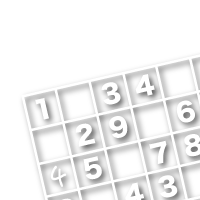
Sponsored Links
TOP > Techniques > X-Cycles
Solving Techniques 11
X-Cycles
Before considering X-Cycles, it’s important to understand strong links and weak links.
Strong link
As shown below, a link where only two numbers are possible in a row, column or box, is called a strong link. In the diagram, it is between [1] and [2].
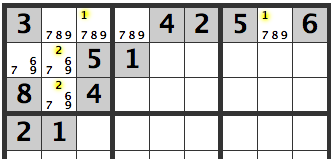
Weak link
As shown below, a weak link is a link where there are more than three numbers that are possible within a row, column or box. [1] and [2] are in three possible cells, which creates a weak link.

X-Cycles
The most simple X-cycle is shown in the diagram below. The red line is the strong link, the dotted red line, the weak link.
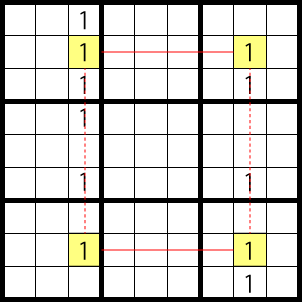
This works the same way as an X-wing and it always works out to:
1
1
or
1
1
Hence, 1 can’t be entered in the areas marked X.
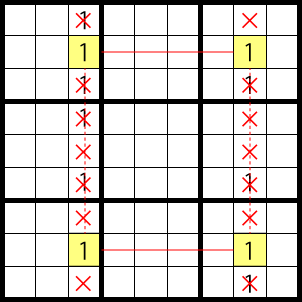
So the X-cycle, of a given number, refers to a
cell - strong - cell - weak - cell - strong - cell
or
cell - strong - cell - weak - cell - strong - cell - weak - cell - strong - cell
type of loop that begins and ends with a strong link. (It also works, if there are strong links, instead of weak within the pattern.)
The number in the weak links can be removed as candidates, but these cells change depending on the situation.
X-Cycles 2
This is a slightly complex pattern. The red line is a strong link, the dotted red line is a weak link.
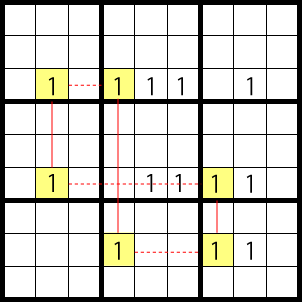
Where the 1 goes is in one of the two patterns below.
Pattern A
Pattern B
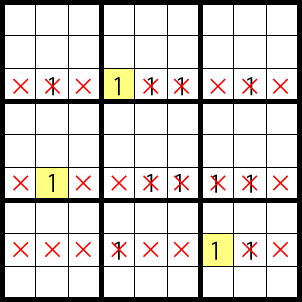
Hence, in the overlapping areas X, 1 can’t be entered, as shown below.
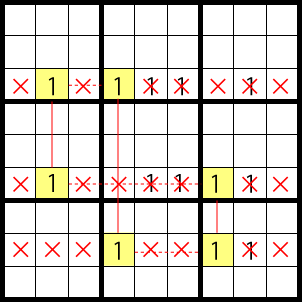
Sponsored Links
X-Cycles 3
Below is another complex pattern. The red line is a strong link, the dotted red line is a weak link.
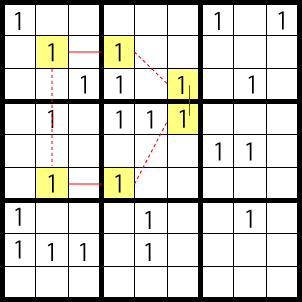
Where the 1 goes, is in one of two patterns below.
Pattern A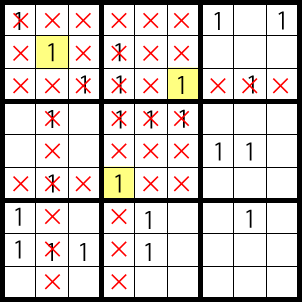
Pattern B

When the two patterns are combined, it becomes like the diagram below.

And in the overlapping areas marked X, a 1 can’t be entered. (The X’s of the strong link are not shown.)
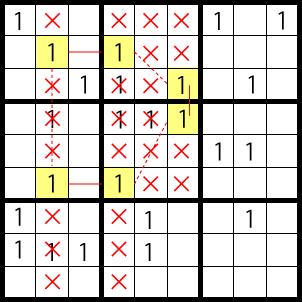
X-Cycles 4
Below is an easy pattern.
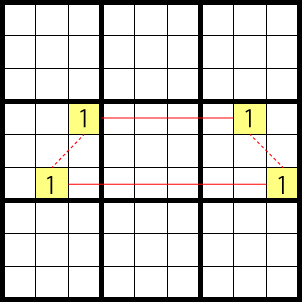
As you can see, 1 can’t be in the areas marked with X’s.
Examining the samples, in each case, the connection in the weak link, if it is a row or column, that row/column’s other cells are removed as candidates. If it is a box, the box’s other cells are removed as candidates.

If you can use this technique, you are quite accomplished at Sudoku.
Names of cells in Sudoku
| R1C1 | R1C2 | R1C3 | R1C4 | R1C5 | R1C6 | R1C7 | R1C8 | R1C9 |
| R2C1 | R2C2 | R2C3 | R2C4 | R2C5 | R2C6 | R2C7 | R2C8 | R2C9 |
| R3C1 | R3C2 | R3C3 | R3C4 | R3C5 | R3C6 | R3C7 | R3C8 | R3C9 |
| R4C1 | R4C2 | R4C3 | R4C4 | R4C5 | R4C6 | R4C7 | R4C8 | R4C9 |
| R5C1 | R5C2 | R5C3 | R5C4 | R5C5 | R5C6 | R5C7 | R5C8 | R5C9 |
| R6C1 | R6C2 | R6C3 | R6C4 | R6C5 | R6C6 | R6C7 | R6C8 | R6C9 |
| R7C1 | R7C2 | R7C3 | R7C4 | R7C5 | R7C6 | R7C7 | R7C8 | R7C9 |
| R8C1 | R8C2 | R8C3 | R8C4 | R8C5 | R8C6 | R8C7 | R8C8 | R8C9 |
| R9C1 | R9C2 | R9C3 | R9C4 | R9C5 | R9C6 | R9C7 | R9C8 | R9C9 |
Sponsored Links

